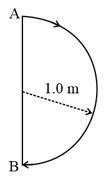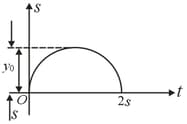Average Velocity and Instantaneous Velocity
Average Velocity and Instantaneous Velocity: Overview
This topic covers concepts, such as, Average Velocity, Instantaneous Velocity, Instantaneous Velocity in Graphs, Average Velocity when Time Intervals Given, Average Velocity when Distance Travelled Given & Average Velocity in Graphs etc.
Important Questions on Average Velocity and Instantaneous Velocity
A particle moves along a straight line such that its displacement at any time t is given by
metres
The velocity when the acceleration is zero is
A particle of mass is moving along the positive -axis under the influence of a force where . At time it is at and its velocity is :
Find the time at which it reaches
A particle of mass is moving along the positive -axis under the influence of a force where At time it is at and its velocity is :
Find its velocity when it reaches
The displacement of particle moving in one dimension, under the action of a constant force is related to the time by the equation where is in meters and in seconds. Find the displacement of the particle when its velocity is zero.
In , a particle goes from point to point , moving in a semicircle of radius (see figure). The magnitude of the average velocity is

A body goes from to with a velocity of and comes back from to with a velocity of . Then, the average velocity of the body during the whole journey is _____ .
The ratio of the numerical values of the average velocity and average speed of a body is always unity or more.
If then average velocity from to is :-
The graph below gives the coordinate of a particle travelling along the X-axis as a function of time. is the tangent to the curve at the starting moment and is tangent at the end moment .

The average velocity during the first seconds is:
A scooter going due east at turns right through an angle of . What is the change in velocity of scooter on taking turn, if its speed remains constant?
Assertion: An object is at rest momentarily when it reverses the direction of its motion.
Reason: An object cannot have acceleration if the velocity of object is zero at a given instant of time
A particle moves rectilinearly possessing a parabolic graph. Find the average velocity of the particle over a time interval from to .

The motion of a particle is described by . Find the initial velocity of the particle.
The motion of a particle is described by the equation , where . It's instantaneous velocity at is:
The position of an object moving along axis is given by , where and is measured in seconds. The instantaneous velocity of the object at is
The position of an object moving along x-axis is given by , Where and and is measured in seconds. The average velocity of the object between and is:
Which of the following statements are incorrect ?
Average velocity is path length divided by time interval.
In general, speed is greater than the magnitude of the velocity.
A particle moving in given direction with a non-zero velocity can have zero speed.
The magnitude of average velocity is the average speed.
Velocity is given by then find time at which velocity is maximum
A particle moves along positive branch of the curve where and are measured in metres and in seconds, then
A person walks along a straight road from his house to a market away with a speed of and instantly turns back and reaches his house with a speed of The average speed of the person during the time interval to is (in )
